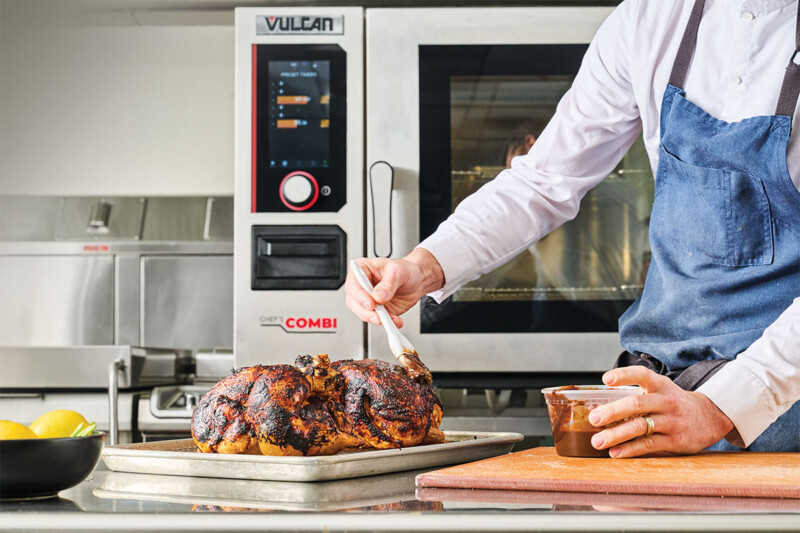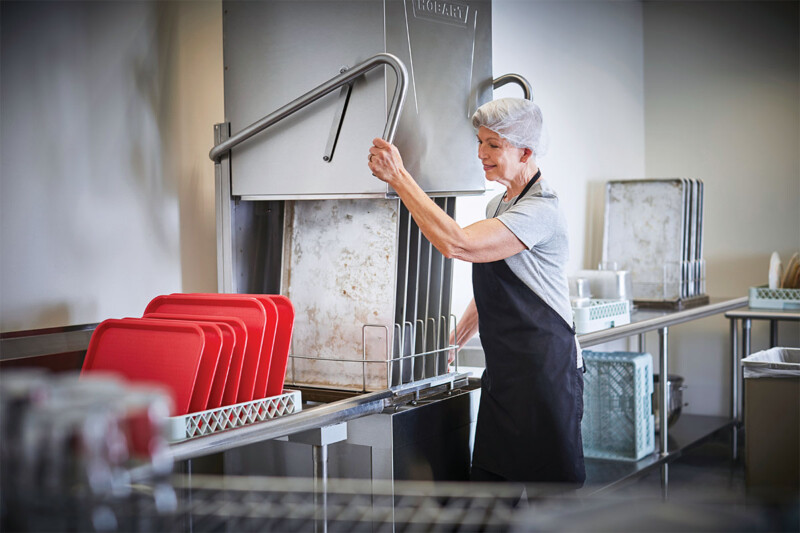Standard ovens, typically found under the burners of a kitchen range, bake and roast most menu items just fine. So, why would you want or need a convection oven? Three key reasons many operators spec convection ovens are size, versatility and speed.
Most full-size convection ovens have the capacity for five sheet pans (some models can accommodate six), so they hold a lot of food. Because they incorporate fans that move air around in the oven cavity, they cook most food in a third less time than standard ovens. And many models have standard or optional features that give them more versatility than standard ovens.
Convection ovens aren’t right for everything. If you feature prime rib, for example, a cook-and-hold oven will suit you better. And if you produce a lot of bakery items or delicate desserts, then your standard oven will do just fine. Otherwise, convection ovens are like utility players on a baseball team: true workhorses that are always ready and produce great results. The following is what you should look for when you’re ready to specify and purchase.
Bring The Heat
Perhaps the first item on the agenda to address is whether to pick gas or electric. Your local utility costs should provide the answer to this one. If electricity prices are competitive with gas in your area, or gas isn’t available, electric models perform just fine.
Some operators prefer gas, suggesting it produces “softer” heat than ovens with electric elements in the oven cavity. When convection ovens first came on the market 50 years ago, the gas versions used indirect heat to bring the oven cavity up to temperature. A lot of the heat went up the exhaust flue. Almost all manufacturers now use direct and indirect heat, recovering some of the exhaust heat by wrapping the flue around the oven cavity.
As a result, a gas oven today that produces anywhere from 45,000-65,000 Btu/hr. is as productive as an old model rated at 70,000-90,000 Btu. Both gas and electric versions now are more energy-efficient than ever and produce consistent results.
Full Of Hot Air
It’s no secret that the key to a convection oven’s consistency is airflow through the oven cavity. Manufacturers use a variety of means to move air evenly and smoothly, with often competing claims about which models do it better. Some models push air through a baffle; some pull it through. Some models have bidirectional fans that change the direction of the airflow. Fan motors range in size from 1/3-3/4 hp. Many models offer a two-speed fan, and a few have a four-speed fan.
All oven manufacturers have learned a lot about fluid dynamics in the past 50 years. Engineers design air-distribution systems to maximize the consistent flow of air in the oven they’re building. While there are likely small differences from one model to another, all get the job done. The only way to really tell which cooks your products most evenly—from one rack to another and from one batch to another—is to test drive several models.
However, you may want two-speed (or more) fans as well as what sometimes is called “pulse.” Both are designed to lessen air movement in the oven cavity so more delicate items aren’t disturbed by the convected airflow; some baked goods and desserts need to “set” properly. The pulse option cycles both the burners/elements and fan in short bursts, maintaining even oven temperature without creating too much airflow.
Open The Door
You can spec your oven with a single or double door. Designers and consultants spec single-door ovens more often in large institutional accounts where larger kitchens often have wider aisles between cooking lines. In tight kitchens, a single door may open too far into the aisle to let line and prep cooks pass.
Double-door ovens are better suited in kitchens with narrow aisles. Most manufacturers make ovens with equally sized doors in a 50/50 split. Some offer the option of doors split 60/40 because when chefs open a door to check the food inside—an inevitable occurrence despite the fact that most oven doors are glass and ovens have lights inside—less heat will escape from a smaller door. (For the same reason, the smaller door usually is positioned on the right because most people are right-handed.)
Depending on make and model, double doors may be dependent or independent. Independent doors open separately and have no other mechanism or parts. However, because cooks typically have one hand full when loading or unloading the oven, most of them want doors that operate dependently: Pull on one handle and both doors open—push and they both close.
Most dependent-door designs use a chain-and-pulley system to open or close the doors simultaneously. One drawback is that the chains can break and/or loosen over time, making it difficult if not impossible to use the oven until the doors are serviced.
One line uses a chain-and-rod system, lessening the length of chain that could potentially stretch, loosen or fail. Another manufacturer adds a flange to one of its independent doors (again, usually the right door), so when a cook pulls on the handle, the flange pops the other door open, too. The second door may not open fully—just enough so cooks can swing it wide easily even with a pan in hand.
Sizing Up, Control
A standard full-size, five-rack convection oven typically has an oven cavity that’s 20-in.H and wide and deep enough to hold an 18-in. x 26-in. sheet pan. If you need more capacity, a couple of manufacturers make ovens with 24-in.H cavities that accommodate six racks, and at least one oven maker builds some of its models with a 28-in.H cavity.
Depending on where a manufacturer locates the controls, an oven with the same 26-in.W x 18-in.D x 20-in.H-range cavity may have a larger or smaller footprint than another make and model. Keep that in mind when your designers or consultants are laying out the kitchen space.
A few other notes about oven size: Some manufacturers make a “deep” or “bakery” model with a cavity large enough to accommodate sheet pans both side-to-side and front-to-back. Before manufacturers got a good handle on distributing air evenly throughout the oven cavity, this type of oven helped operators compensate for an uneven bake by alternating the direction of pans in the oven. More airflow around the pans often resulted in a more even bake.
Now, the only reason you’re likely to need a deep oven is if you rethermalize a lot of frozen food. The additional interior space could help your oven cook and recover faster. Otherwise, the larger size will just take up unnecessary, and valuable, real estate.
If you need more capacity, get a stackable model and put two in the same footprint. Conversely, if you don’t cook enough volume to warrant a full-size convection oven, several makers build half-size ovens with the same benefits in a smaller package.
Some manufacturers also offer the option of putting controls on the right or left side of the oven, depending on which end of the line you locate them. Controls shouldn’t be exposed to temperatures of more than 200°F (for most models) or grease and steam. If you put the oven on the line next to a fryer or broiler, you’ll want the controls located on the side farthest from the heat.
Economy models still may have electromechanical controls, such as thermostats, but look for solid-state controls and electronic ignitions for gas ovens. Programmable ovens are a step up, but unless you have products with multiple cooking steps, you may not need the capability, and it may just confuse employees.
Bells And Whistles
Even if you don’t need a programmable oven, makers offer a range of options you might find useful. Here are a few:
• Dual Btu switch. Some gas models can switch from an energy-efficient mode to a higher Btu/hr. burner rate for faster recovery and cook times for heavy-duty loads.
• Water injection. A few models let you inject water into the oven cavity or onto the electric elements, raising the humidity in the oven so it cooks more like a combi oven. Water helps reduce roast shrinkage, too.
• Food probe. Temperature probes work especially well with protein items—roasts, etc.—and heavy pans of food—refried beans, casseroles, etc.—in programmable ovens.
• Slide-out racks. In some models, the entire rack frame is on rollers and slides easily out of the oven.
• Rack hangers. Before putting 2- or 4-in.D hotel pans in the oven, employees take out racks to make room. A rack hanger lets you store the removed racks off of the floor, clean and undamaged.
A good thing about these utility players is that, unlike high-end star players, they help you live within your salary cap. Virtually all convection models will do the oven-cooking jobs you have at hand, but some careful comparison will help you select a model with the features you need at a price you can afford.
SIDEBAR:
Cooking Tip
Convection-oven temperatures should always be set 25°-50° lower than you would set a regular oven, but for preheating, you can set the oven 25°-50° higher than a regular oven, then turn it down as soon as the pans are loaded. If you’re cooking more delicate items, such as cupcakes, cakes, etc., whose tops might push to the side when the fans are running, here’s a tip: After the preheat, load the pans and turn the oven off to give the delicate items a chance to “set.” Then turn on the convection for a quick finish.
RELATED CONTENT
- Advertisement -
- Advertisement -
- Advertisement -
TRENDING NOW
- Advertisement -
- Advertisement -
- Advertisement -


